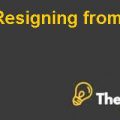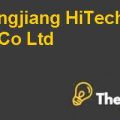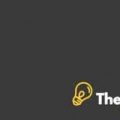FINCH CO: CASE ANALYSIS CASE SOLUTION
Case Analysis: Finch co
Anwer no 1
Free Cash Flows
The projected income financial statements are given in the case which has been prepared by the company using the appropriate assumptions and estimations. The financial statements have been made for the year 2011, 2012 and 2013. The revenues are expected to increase at the levels of 2009 in 2011; afterwards they are expecting to increase at a projected rate of 7.9% and 3.2% for 2012 and 2013 respectively. Gross margins are expected to remain 33% of the sales and the cost of goods sold is expected to remain 67% in the upcoming years.
On the basis of the information provided the free cash flows of the Finch Co have been calculated. The appropriate tax rate on average is 30% and the capital expenditures are assumed equal to the amount of depreciation. Therefore, the cash flows are indicating the balances in CD $ 1,890,000, 2,275,000 and 3,092,000 for the year 2011, 2012 and 2013 respectively. This balance will be available for the company in order to expand its operation or to utilize these cash flows as per the need after the capital expenditure.
It can be estimated that the company’s financial health is quite stable since these cash flows are positive and the company will have a large amount to fund its expenses and to pay its liabilities. Moreover, it’s a great sign from the investors’ perspective that the investor can surely earn profit on their investment.
The Finch Co’s free cash flows and EBIT will grow to an expected rate of 19% and then 7% in the year 2012 and 2013 respectively.
Answer no 2
Cost of Equity
Cost of equity is mainly the rate of return which the company is offering its stock holders. It incorporates all the risk and rewards of those investors who are investing in company’s equity. Generally it’s the part of WACC along with the cost of debt included in it. (Brimigham, 2014)
Using a debt to equity ratio of 40% the cost of equity is being calculated in our case by benchmarking a similar industry company namely Toromont industries. The assumption has been used as per the suggestion of Ms Bhathal. Capital Asset Pricing Model (CAPM) has been used for the calculations of cost of equity. The risk free rate is 3.6% market beta is 0.8 and market risk premium is 6% in our analysis. The WACC of the company is 6.51% including cost of debt of almost 3.68%.
The cost of equity is indicating a rate of 8.6% which shows that the investor who will invest in finch co will earn almost 8.6% on his stock associated with Finch co. however, the beta of the company is far more lesser than the market beta or we also call it a defensive beta which indicates that the firm is less risky than the other industry players.
If we talk about the company from investors’ point of view, then the company is very important for them. Since, the company is generating almost 8.6% profit from them on their equity securities. The factors which we included in CAPM can also change the firm value and cost of equity, if changes occur to the market.....................
This is just a sample partial case solution. Please place the order on the website to order your own originally done case solution.











